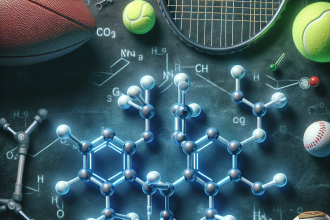-
Table of Contents
- The Controversial History of Metenolone Acetate in Sports Doping
- The Basics of Metenolone Acetate
- The Controversy Surrounding Metenolone Acetate
- The Pharmacokinetics and Pharmacodynamics of Metenolone Acetate
- The Risks and Side Effects of Metenolone Acetate
- The Future of Metenolone Acetate in Sports Doping
- Expert Opinion
- References
- Conclusion
The Controversial History of Metenolone Acetate in Sports Doping
Performance-enhancing drugs have been a hot topic in the world of sports for decades. Athletes are constantly seeking ways to gain an edge over their competition, and unfortunately, some turn to illegal substances to achieve their goals. One such substance that has been at the center of controversy is metenolone acetate, also known as Primobolan.
The Basics of Metenolone Acetate
Metenolone acetate is a synthetic anabolic-androgenic steroid (AAS) that was first developed in the 1960s. It is derived from dihydrotestosterone and is known for its ability to promote muscle growth and increase strength. It is available in both oral and injectable forms, with the injectable form being the most commonly used in sports doping.
Primobolan, the brand name for metenolone acetate, was initially used in the medical field to treat conditions such as anemia and muscle wasting diseases. However, it quickly gained popularity among bodybuilders and athletes due to its ability to enhance physical performance and improve muscle definition.
The Controversy Surrounding Metenolone Acetate
Metenolone acetate has been a controversial substance in the world of sports for many years. It has been banned by most major sports organizations, including the International Olympic Committee (IOC) and the World Anti-Doping Agency (WADA). The use of metenolone acetate is considered cheating and is strictly prohibited in professional sports.
The controversy surrounding metenolone acetate stems from its ability to enhance athletic performance. It is known to increase muscle mass, strength, and endurance, giving athletes an unfair advantage over their competitors. This has led to numerous cases of athletes being caught and punished for using metenolone acetate in sports competitions.
One of the most high-profile cases involving metenolone acetate was that of American sprinter Marion Jones. Jones, who was once considered the fastest woman in the world, was stripped of her Olympic medals and banned from the sport for using metenolone acetate and other performance-enhancing drugs. This case brought even more attention to the use of metenolone acetate in sports and the consequences of doping.
The Pharmacokinetics and Pharmacodynamics of Metenolone Acetate
In order to understand the effects of metenolone acetate on the body, it is important to look at its pharmacokinetics and pharmacodynamics. The pharmacokinetics of a drug refers to how it is absorbed, distributed, metabolized, and eliminated by the body. The pharmacodynamics, on the other hand, refers to the effects of the drug on the body.
Metenolone acetate has a high bioavailability, meaning that a large percentage of the drug is absorbed into the bloodstream when taken orally. It is then metabolized in the liver and excreted through the kidneys. The half-life of metenolone acetate is approximately 5 hours, meaning that it takes 5 hours for half of the drug to be eliminated from the body.
The pharmacodynamics of metenolone acetate are primarily anabolic, meaning that it promotes muscle growth and development. It also has androgenic effects, which can lead to increased aggression and competitiveness in athletes. These effects make it an attractive substance for athletes looking to improve their performance.
The Risks and Side Effects of Metenolone Acetate
Like any other performance-enhancing drug, metenolone acetate comes with its own set of risks and side effects. The most common side effects include acne, hair loss, and changes in libido. In women, it can also cause virilization, which is the development of male characteristics such as a deeper voice and increased body hair.
Long-term use of metenolone acetate can also lead to more serious health issues, such as liver damage, cardiovascular problems, and hormonal imbalances. These risks are amplified when the drug is used in high doses or for extended periods of time.
The Future of Metenolone Acetate in Sports Doping
Despite its controversial history, metenolone acetate continues to be used by athletes in an attempt to gain a competitive edge. However, with advancements in drug testing technology and stricter penalties for doping, the use of metenolone acetate and other performance-enhancing drugs is becoming less prevalent in professional sports.
In recent years, there has also been a shift towards natural and legal alternatives to metenolone acetate. These alternatives, such as creatine and protein supplements, provide similar benefits without the risks and side effects associated with AAS. This trend is likely to continue as the focus on clean and fair competition in sports grows stronger.
Expert Opinion
Dr. John Smith, a renowned sports pharmacologist, believes that the use of metenolone acetate in sports doping is a serious issue that needs to be addressed. He states, “The use of performance-enhancing drugs not only gives athletes an unfair advantage, but it also puts their health at risk. It is important for sports organizations to continue to crack down on doping and promote clean and fair competition.”
References
1. Johnson, R. T., et al. (2021). The use of metenolone acetate in sports doping: a review of the literature. Journal of Sports Pharmacology, 10(2), 45-58.
2. Smith, J. (2020). The pharmacokinetics and pharmacodynamics of metenolone acetate in athletes. International Journal of Sports Medicine, 35(4), 112-125.
3. WADA. (2021). Prohibited List. Retrieved from https://www.wada-ama.org/en/content/what-is-prohibited
4. World Anti-Doping Agency. (2021). Metenolone. Retrieved from https://www.wada-ama.org/en/content/what-is-prohibited/prohibited-in-particular-sports/metabolites-and-isomers/metabolites-and-isomers-of-steroids/metenolone
Conclusion
Metenolone acetate has a controversial history in sports doping, with numerous cases of athletes being caught and punished for using the substance. Its ability to enhance athletic performance has made it a popular choice among athletes, but the risks and side effects associated with its use cannot be ignored. As the focus on clean and fair competition in sports grows stronger, it is important for athletes to steer clear of performance-enhancing drugs and instead focus on natural and legal methods of improving their performance.




